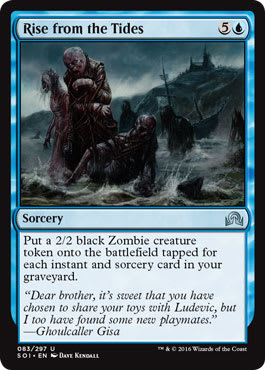Last weekend, we all had a delirium of fun at the prerelease for Shadows over Innistrad. We howled at the moon with our new four-legged friends. And we cackled when summoning skaab abominations—at least I did.
Our stay in Innistrad is pleasant enough at Regular Rules Enforcement level. At more competitive tournaments, remembering Werewolf and delirium triggers will be maddening—and critical for victory. In Foolproof Magic, we learn good habits to avoid the simple mistakes that can sabotage our master plans. Tonight, take some silver-bladed technology with you to help survive SOI Limited.
Problem: Remembering Werewolf Triggers
We should be comfortable remembering triggers during our own upkeep by now. But a trigger on our opponent’s turn is another beast entirely. We may have even skipped casting a spell on our turn because transforming a Werewolf is our only hope. Forgetting the trigger could then lead us out of Kessig and straight to Tiltville.
Foolproof Tip: Die in Hand Method

Remembering a strange triggered ability will require a strange new technique. After casting a Werewolf, place a dice in your hand, the hand that you use to pass the turn to the opponent. Keep it in your grip. As you make the accustomed gesture, you’ll feel something odd. A chill will pass down your spine. Your hackles with rise. Check the moon, and see if it’s time to transform your Werewolves.

If the die is in the same hand you use to draw from your library, you have a twofer for your own upkeep. But what if you do not usually wave your hand to signal the end of your turn? In that case, consider instead using the method of Focusing by Touch.
Problem: Identifying Delirium
Keeping track of Humans transmogrifying into Werewolves is hard enough, but optimal play also requires delirium. The triggers of such distinguished craftsmen as Tooth Collector will go on the stack at the same time as Werewolves. Use the identical method to track delirium. But I wouldn’t want to pick up a die after casting a turn-one Topplegeist, for an ability that won’t activate until turn ten.
Foolproof Tip: Arrange Graveyard, Deviously
Never missing a delirium trigger means recognizing at once when our graveyard is replete with for card types. The simplest solution would be to arrange our graf into piles, and once we see four mounds of earth, we’ll know our time has come. But so will our opponent. Some degree of subtlety may allow us to remember and yet surprise—while also staying within the rules by keeping all your graveyard cards touching.

You can manage this in the pattern that makes most sense to you. For me, I will keep all my creatures in one pile. Every other card type will be placed at a slant, and the fourth one will be at a ninety-degree angle. I used the same practice for delve, and I can track my progress to delirium with my peripheral vision. When my eyelid starts to twitch, when I begin to hear gibbering whispers, I’ll pick up my die and hold it tight.
Problem: Tracking Tokens
Speaking of managing graveyards, the inferior sort of necromancers will place Zombie tokens into play tapped. Other practitioners will animate them untapped, and the distinction between these cards isn’t obvious.
A competitive Limited event is no place to use dice to indicate tokens. Buy real ones from previous sets if you have to, or from any number of artistic alternatives. Using the back of a stray card also won’t do. We need to keep in mind if a 1/1 token is a Human Soldier, a Vampire with lifelink, or a Spirit with flying.
Foolproof Tip: Use Real Tokens

Problem: Forgetting Clue Triggers
Clues are a new token type. When we sacrifice one for more information, our focus is on picking up the Clue, and our mind is on that tantalizing new card. What will we discover? The suspense is delicious. In such a state, we’re likely to forget any effects that trigger when sacrificing the Clue, such as from your best friend the mole detective. Keep track of these bonuses with a reminder die near your Clue token.
Solution: Proximity Die

I will use this technique to remind me to place multiple Clues in play as well from Erdwal Illuminator. And I’m likely to place another die near my graveyard, as a reminder of the number of cards that have flashback-style abilities, such as Stitchwing Skaab or Ghoulcaller's Accomplice. If these die early and my mana isn’t freed up until late, I might forget these trusty servants with their fashionable dusting of graveyard soil.

A die would help me remember them. Better yet, if I’m not arranging my graveyard to count delirium, I can tilt the business cards at an angle, as blatant as a corpse’s arm sticking out of the graft turf. If delirium is also key to my strategy, I could instead count that number with a die and angle my Dauntless Cathar. As I always say, the only good cathar is a dead one.
Problem: Forgetting Graveyard Abilities
Solution: Yes, Yet Another Die!
The techniques of Foolproof Magic will require practice to ingrain into muscle memory. Doing so will allow us to focus on higher-level strategy necessary to bring our diabolical plans to fruition. Seeing what scheme to execute in any situation requires practicing the format. However, we sometimes lack all the resources for exhaustive testing. Shaun Penrod of the MTG Pro Tutor podcast told me some of the problems faced by would-be grinders.

Problem: Insufficient Time & Money to Practice
While the solution to these problems does stray beyond the mechanical methods of Foolproof methods, I can offer advice. I will use most of it myself to prepare for the SOI Limited format of Grand Prix Albuquerque.
I have, on average, an hour and a half for Magic on weeknights. That’s only enough time to start a Draft on Magic Online and lose the first round. But the new Sealed leagues let you build at your leisure and play your rounds whenever. This is the best way to jam more practice into your workweek, if you can afford it.
You can read articles online and watch videos for free (or cheap). Listening to Magic podcasts is a great way to pass the time of commutes. Do leave a comment below with your media suggestions.
As for me, Magic Online won’t suffice because SOI releases on the same weekend as the Grand Prix. To practice beforehand, I’ll build mock Sealed decks on TappedOut.net. The website permits you to playtest two decks against yourself by opening multiple browser windows.
Or I’ll shuffle up a paper deck and play it against one online. I enjoy this more than using proxies, as TappedOut shows me the card with its art. It feels like a game again rather than a chore. If I’m playing a Constructed format, my personal deck against another, I’ll compensate for my biases by allowing take-backs for the opposing deck and free looks at the top of the library. To play both sides, I’ll need to be familiar with both decks, something that will be necessary in any event to master a format.
Like any good scientist, I’m taking notes on my testing. May your own research endeavors in Innistrad produce multi-armed magnificence.



























